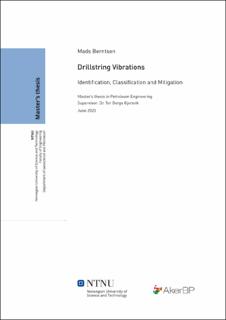| dc.contributor.advisor | Dr. Gjersvik, Tor Berge | |
| dc.contributor.author | Berntsen, Mads | |
| dc.date.accessioned | 2021-09-24T17:50:46Z | |
| dc.date.available | 2021-09-24T17:50:46Z | |
| dc.date.issued | 2020 | |
| dc.identifier | no.ntnu:inspera:54976536:36181158 | |
| dc.identifier.uri | https://hdl.handle.net/11250/2781590 | |
| dc.description.abstract | Denne masteroppgaven bygger på arbeidet fra prosjektoppgaven i faget TPG4560. Noen deler er tatt direkte fra prosjektoppgaven, kalt «Drillstring Vibrations: A Theoretical Foundation». Masteroppgaven var skrevet i samarbeid med Aker BP, et operatørselskap som identifiserte et potensiale ved å gi interne ingeniører et solid teoretisk grunnlag om borestrengsvibrasjoner. Hovedansvaret med å håndtere og mitigere borestrengsvibrasjoner foreligger hos ingeniører fra innleide serviceselskap. Disse serviceselskapene har ofte sine egne patenterte eller klassifiserte prosedyrer, arbeidsflyter og verktøy for å redusere vibrasjoner. Ingeniører ved operatørselskap må samarbeide med flere forskjellige serviceselskap og dermed vil besittelse av en god og generell teoretisk base om borestrengsvibrasjoner være behjelpelig i samhandlingen med de forskjellige serviceselskapene. Det vil også hjelpe med å sikre operatørens interesser når avgjørelser må tas i forbindelse med borestrengsvibrasjoner som kan sette boreoperasjonen i fare.
Formålet med denne oppgaven er å gi innsikt om de forskjellige vibrasjonsformene, mekanismene som påvirker vibrasjoner, potensielle konsekvenser, måter å identifisere de forskjellige vibrasjonstypene samt verktøy og teknikker for å mitigere skadelige borestrengsvibrasjoner. Det brede omfanget til oppgaven er valgt for å gi ingeniøren en bred forståelse av hvordan vibrasjoner påvirker borestrengen. En kombinasjon av etablerte borekonsepter og nyvinninger innenfor boreverktøy og prosedyrer er beskrevet for å knytte sammen underliggende fysiske prinsipper med topp moderne teknologi. Nylige utviklinger innenfor målingsverktøy og sensorer har «skrudd på lyset» i brønnen slik at nå har et bedre bildet av den dynamiske oppførselen til borestrengen. Av denne grunn er nye anti-vibrasjonsverktøy og prosedyrer vektlagt. Undersøkelsene er hovedsakelig basert på litteraturstudier med spesielt fokus på felterfaringer for å forsikre at praksis og teori er i overenstemmelse.
Viktige funn i oppgaven er at flere felterfaringer indikerer at de forskjellige verktøyene beskrevet i denne oppgaven gir signifikant bedre vibrasjonsnivåer. Stick-slip og whirl, de vanligste vibrasjonsformene, er bevist redusert gjennom bruken av roller reamers, anti stick-slip teknologi (AST), depth of cut control (DOCC), soft torque rotary systems (STRS) og drilling advisory systemer. Oppgaven avdekte også hvordan nyvinninger og forbedringer innen måleteknologi har ført til oppdagelse av nye vibrasjonsformer, eksempelvis high frequency torsional oscillation (HFTO). Begrensninger av båndbredde for konvensjonelle MWD systemer avslørte utfordringene knyttet til identifisering av vibrasjoner i sanntid i tillegg til å belyse potensialene ved wired drill pipe (WDP). | |
| dc.description.abstract | This master`s thesis builds on the work done in the specialization project TPG4560. Some parts are taken directly from the project report, which was titled “Drillstring Vibrations: A Theoretical Foundation”. This thesis was written in collaboration with Aker BP, an operator who recognized the potential in giving engineers at an operating company a solid understanding of drillstring vibrations. The responsibility of handling and mitigating drillstring vibrations is predominantly engineers from service companies. These service providers often have various patented or classified procedures, workflows and tools to combat vibrations. An engineer at an operating company is required to cooperate with several service providers and gaining a solid theoretical foundation of drillstring vibrations will aid the engineer in cooperating with the different service providers. It will also help the engineer to protect the operator`s interests when decisions are to be made where drillstring vibrations pose a serious risk to the operation.
The main objective of this thesis is to provide insight of the various vibration modes, the mechanisms affecting vibrations, potential consequences, ways of identifying the various vibration types and tools and techniques to mitigate detrimental vibrations. The wide scope of the thesis is chosen to provide the engineer with a broad understanding of the vibrational behavior of the drillstring. A combination of longstanding drilling physics and novel technology developments is described in order to tie together the underlying physical principles of drilling with state-of-the-art technology. The recent developments within measurement tools and techniques have “turned the light on” downhole for dynamic behavior. For this reason, particular focus is given to new anti-vibration tools and procedures. The research is mainly based on literature reviews with emphasis on the reported field experiences to ensure that practice complies with theory.
Important findings and takeaways from the thesis are that field trials indicate that many tools are successful in reducing vibration levels. Field validations have shown that whirl and stick-slip, the most common drilling dysfunctions, have been effectively negated through the use of roller reamers, anti stick-slip technology (AST), depth of cut control (DOCC), soft torque rotary systems (STRS) and drilling advisory systems. The thesis also revealed how the increase in measurement technology have illuminated new vibration types, such as high frequency torsional oscillations (HFTO). The limitation in bandwidth of conventional MWD systems highlights the challenges in real time vibration detection as well as highlighting the potential of wired drill pipe (WDP). | |
| dc.language | eng | |
| dc.publisher | NTNU | |
| dc.title | Drillstring Vibrations - Identification, Classification and Mitigation | |
| dc.type | Master thesis | |
